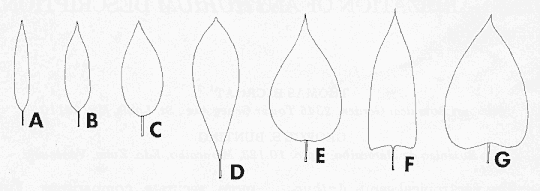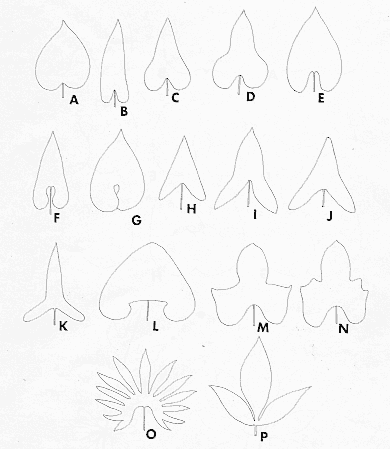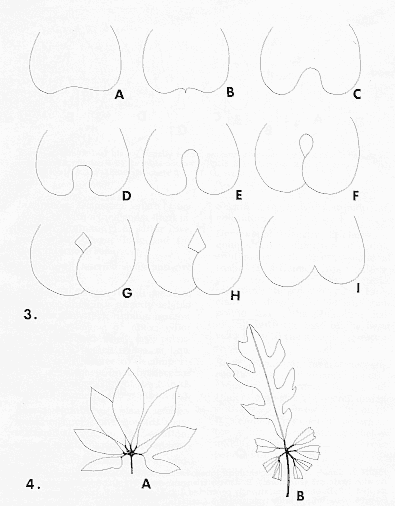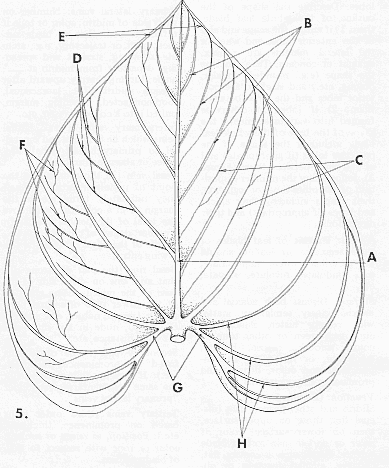DESCRIPTION
Habit: rosulate, subrosulate, erect, suberect, scandent, pendent, creeping, climbing, etc.
Roots: Type, e.g. feeding, clasping, etc.; quantity, thickness, color (often white, red, brown or green); disposition, e.g. loose and spreading, slender and directed upward, thick and more or less congested, etc.
Stem: Overall length, cross-section shape (if distinctive), color, texture.
Internodes: Diameter, length (more or less uniform, or with a long and a short internode alternating; in latter case, give length of the long and the short internode separately).
Leaf Scars: Describe shape and give dimensions.
Cataphylls: Length (width need not be given, since it is directly related to stem diameter); ribbing, as faint or strong; shape of apex; color when fresh and when dry; persistence and at which nodes , at how many nodes, degree of decomposition, consistency (membranaceous if epidermis persists but the fibrous network clearly shows through).
Leaves: Number per plant; arrangement, e.g., clustered toward apex, scattered along stem, etc.; position, such as erect, spreading or pendent.
Petiole: Length; thickness at midpoint (if quite variable throughout its length, give the thickness at base, midpoint and near apex); cross-sectional shape, such as terete, 4-gonous, semiterete and narrowly or broadly canalicualte adaxially; sharpness of canal margins; color, texture. location and number of ribs if discernible.
Sheath: Length; width at midpoint, coloration.
Geniculum: Length; thickness in comparison to thickness of petiole contiguous with it; cross-sectional shape if different from petiole; color (often paler than petiole, sometimes tinged red, etc.). Especially in deeply divided and compound leaves, the geniculum may extend onto the base of the basal veins or onto the petiolules, respectively.
Blade: Texture: membranaceous, chartaceous, semicoriaceous, coriaceous, thick, brittle, fleshy, etc. Dimensions: give the overall dimensions, whether simple or compound. It should always be noted where the width is greatest, e. g. , below middle, at middle, ca.___ cm above petiole insertion, etc.
Shape: Common shapes of Anthurium leaf blades ( Figures 1-4).
Figure 1: Simple , usually entire, without conspicuous posterior lobes. Describe shape of outline of whole leaf blade, then shape of the apex, followed by shape of the base.
 |
| Figure 1. Simple leaf blades, usually entire, without conspicuous posterior lobes: A. oblong narrow elliptic 6:1; B. ovate-narrow elliptic 3:1; C. ovate 2:1; D. narrow obovate 3:1; E. ovate 3:2. 5:1; F. triangular-ovate 2-2.5:1; G. ovate 3:2. |
Figure 2: Simple, entire or lobed, usually with conspicuous posterior lobes. Describe the shape of the outline of the whole leaf blade, then: 1) if entire, the shape and size of the anterior lobe, and whether the lateral margins are convex, straight or concave. Then describe the shape (e. g. , rounded, angular,oblong,etc. ) and size** of the posterior lobes and the sinus between them; 2) if lobed or otherwise formed into various segments, the shape of the base of the whole leaf blade including the shape of the posterior lobes (if appropriate) and of the sinus between them (Figure 3), followed by the number disposition of the other lobes or segments, their shapes including their apices and bases (if appropriate) and their dimensions.
 |
| Figure 2. Simple leaf blades entire or lobed, usually with conspicuous posterior lobes: A. wide ovate 6:5 (cordiform); B. narrow triangular-ovate 3:1; C. obpyriform, little constricted 3:2; D. obpyriform, strongly constricted 3:2; E. ovate 3:2; F. triangular-ovate 2:1; G. wide ovate 6:5; H. wide triangular 6:5 (sagittate); I. subhastate; J. subtriangular 1:1; K. hastate; L. very wide ovate 5:6 with birettiform sinus; M. trilobed with truncate lateral lobes; N. Trilobed with premorese lateral lobes; O. transversely wide elliptic 5:6, pedato radiate; P. tripartite with central lobe elliptic 2:1 and lateral lobes ovate 2:1. |
 |
| Figure 3. Some shapes of the sinus between posterior lobes: A. arcuate; B. arcuate with bald decurrent on the petiole; C. parabolic; D. hippocrepiform; E. spathulate; F. obovate; G. rhombic; H. mitered; I. triangular.
Figure 4. Compound leaf baldes, pedately or palmately compound: A. transversely wide elliptic 5:6, leaflets obovate 2.5-3:1 and entire; B. circular, leaflets obovate 2:1 and pinnatifid. |
Margin:Margins of leaf blades or their segments or leaflets should be described where appropriate, e. g., undulate, revolute, sinuate, etc.
Surface: Discuss both adaxial and abaxial; glossy, semiglossy, matte, with velvety luster, glaucescent, etc.; dark green or other tone or color; smooth, rugose, bullate, epunctate, or raised- or sunken- punctate, and color, density and prominence of punctations, etc.
Venation: (Figures 5 & 6) Midrib and other primary ribs (discuss first those on uppper surface, then on lower surface) color, if paler or darker than rest of blade surface; Form, such as convex, flat, concave, angular (acutely or obtusely ), V-shaped, U-shaped, omegashaped; position, as raised, sunken, or in valleys; note any change throughout the length of blade.
 |
 |
| Figure 5. Venation types: A. midrib; B. primary lateral veins; C. interprimaray veins; D. secondary veins; E. collective veins; F. tertiary veins; G. basal ribs; H. basal veins. | Figure 6. Venation types: A. midrib; B. primary lateral veins; C. interprimary veins; D. tertiary veins; E. lesser reticulate veins; F. collective vein. |
These terms apply to all of the categories of veins described below.
Primary lateral veins; Number on each side of midrib; color or tone of different from that of blade surface; path or trajectory, e. g. ,arcuate-ascending , straight and spreading , departing from midrib at____degrees angle, turning sharply upward after leaving midrib (i.e., lauraceous), loop-connected, reaching margin, united into a collective vein, etc.
Interprimary veins ( weak lateral veins which lie between an more or less parallel to primary lateral veins): Presence or absence; number.
Basil vein ( all those arising at the point of petiole insertion, even if they ultimately terminate at the margin or in a collective vein above the level of the petiole insertion): Number; degree of coalescence, i.e.,length of the basal rib (see the following entry).
Basal ribs ( the pair of strong ribs that arise on either side of the base of the midrib, being a fusion of the lower part of several basal veins): Length; nature, e.g., straight or curved, nude in the sinus and for what distance, etc.
Secondary veins ( second order veins based on prominence, thickness, etc.): If present, follow essentially the same commentary given under "primary lateral veins".
Tertiary veins (third order veins based on prominence, thickness, etc.): Position, as raised or sunken; color or tone with respect to that of blade surface.
Lesser reticulate veins ( generally the smallest reticulations visible to the naked eye ): Intensity, as visible, prominent; position, as raised or sunken; size of areoles.
Collective vein ( a continuation of a primary lateral vein, often the lowermost one, or of the uppermost basil vein): Path, as more or less smooth, scalloped, etc.; distance from margin. If collective vein is indistinct, it may be best to describe the primary lateral veins as loop-connected. Secondary collective veins may be present; if so, indicate their place of origin. Any discussion of collective veins is assumed to refer to the primary collective vein unless qualified.
Inflorescence:
Peduncle: Length; thickness, form, e.g., terete, ribbed (note the strength number and position of ribs), striate, etc., color: markings, e.g., dotted, short-dashed with paler green, etc.; ratio of peduncle/petiole length; position, e.g. erect, spreading, pendent, and changes in age.
Spath: Describe features in the following order: Texture, color, including changes in color; surface, e.g., matte, glossy, etc.; longevity; (Figure 7) angle at which spathe is held from spadix, e.g. spreading, erect, recurved, etc.; dimensions and where broadest ( measure length from base of the insertion but do not include any decurent portions); shape including deformations, e.g., doubled longitudinally, revolute, etc.; apex shape; base shape, margins meeting on peduncle at____degrees angle, etc.. ( Figure 8).
Spadix: Shape ( Figure 9).
A. cylindric
B. tapered
C. clavate
D. subglobose
Give dimensions: measure length on both the anterior an posterior side, if different; if tapered, measure diameter near base and near apex; form, e.g., straight, curved at _____degrees angle to peduncle, etc.; color at anthesis and post-anthesis.
 |
| Figure 7. Inflorescence showing angle of insertion of the spathe on the peduncle. Figure 8. Anterior view of inflorescence showing the angle at which the spathe margins meet on the peduncle; A. almost meeting, then decurrent; B. acute, meeting at 40 degree angle; C. obtuse, meeting at ca. 110 degree angle; D. meeting at 180 degree angle; E. cordate. Figure 9. Spadix shapes: A. cylindric; B. tapered; C. clavate; D. subglobose. |
Stipe: If present, give color and dimensions (measure length on posterior (shorter side) and on anterior (longer side); if absent, indicate that spadix is sessile.
Flowers: Functionally unisexual or bisexual; sequence of development of anthers and stigmas, e.g., protogynous, markedly protogynous,etc. outline ( usually square or rhombic but sometimes 4-lobed, or often with 2 margins straight and parallel and 2 margins sigmoid and parallel); dimensions (taken parallel to axis and also perpendicular to axis) directions of spirals, either left or right handed, and number of flowers per spiral ( Figure 10).
 |
| Figure 10. Spadix showing spiral arrangement of flowers: A. principal spiral; B. secondary spiral. Figure 11. Close up of an individual flower; A. lateral tepals; B. anterior and posterior tepals; C. apical view of pistil showing stigma. |
Tepals: Consider only their exposed apical part; color at anthesis and changes in age; surface, e.g., matte, glossy, semiglossy, punctate, bearing scattered nectar droplets; form of inner margins, e.g. straight or convex, etc., overlapping before anthesis, held somewhat erect against the surface of the emerging pistil, etc.
Pistil: Length and shape at anthesis; shape and dimensions of portion exposed between the tepals or of portion exposed above tepals.
Stigma: Brush-like and raised, or sunken and linear, oblong, ellipsoid, punctiform, etc. ( a linear stigma may become punctiform in fruit); dimensions.
Stamens: Length exerted above tepals; pattern of emergence,i.e., beginning in the middle of, at base of, or scattered over, the spadix, etc.
Filaments: Flattened and sometimes convex on abaxial surface, fleshy, markedly tapered near apex, etc.
Anthers: Dimensions: disposition, e.g., introrse, becoming inverted in age, etc. (exerted anthers often are later withdrawn to level of tepals by shrinkage of filaments); spacing of anthers around pistil, e.g., forming a tight circle or dense globular cluster; space between the anthers equal to width of an anther, etc.
Infructescence: Position, e.g., erect, spreading, arcuate-pendant, pendent, borne at leafless nodes, etc.
Fruit: Shape; dimensions; color(s)(indicate uniformity of color), pattern of exsertion, e.g. simultaneously all over the spadix, or slowly exserted throughout a period of time and in a scattered pattern.
Pericarp: Texture, thickness, presence of cystolyths, etc.
Mesocarp: Color; consistency, as gelatinous and translucent, mealy, firm, etc.
Seeds: Shape, size, color, number per fruit.
It is important to indicate which parts of a description have been prepared from living material and which from dried material; If necessary, discuss any changes created in drying, giving special attention to the shape of sinus, leaf base, etc.
HABITAT: Describe the habitat of the species, e.g., terrestrial in deep shade, on steep forested slopes, on open stream banks, epiphytic in tree crotches, epiphytic below the crown of a tall palm, on rocks in full sun, hemiepiphytic on trunk of tree, etc.
DISTRIBUTION: State the areas where the species is known to occur.
DISCUSSION: Certain other data should be included with each description. These include a discussion of life zones where the species occurs, and the altitudinal and geographic ranges. One should always attempt to discuss the characters that separate a species from the more closely related cogeners. Any other data known about the species should be given, such a common names, local uses, details of reproductive biology as well cytology, anatomy, pollen morphology, etc.
ILLUSTRATIONS: Because of the complexity of the taxonomy of Anthurium and of other Araceae, all descriptions should be augmented by good photographs made from live material or by drawings.
We would like to make a strong plea to all collectors that they give much attention to the field notes describing their collections. These notes should always indicate habitat, habit, length of stem, length and thickness of internodes, petiole shape in cross-section, color of spathe and spadix, disposition of inflorescence, and shape and color fruits.
* The descriptive ideas mentioned here are intended only as a guide and are not necessarily complete; one must be ready to supply new categories or words to describe a specimen in hand, or to add some concept not included in the outline.
** Posterior lobes are usually best measured from point of petiole insertion to the point furtherest away. If the basal lobes overlap, it is desirable to give also the length from the point of petiole insertion to the base of the blade.
Copyright © 2007 by Neil Carroll. All rights reserved.
This article first appeared in Aroideana Vol.2, No. 1, Jan. 1979 and is reprinted here with the permission of the senior author.